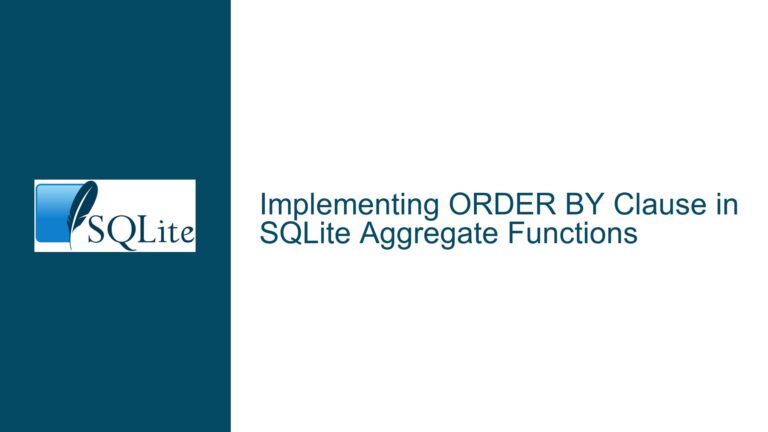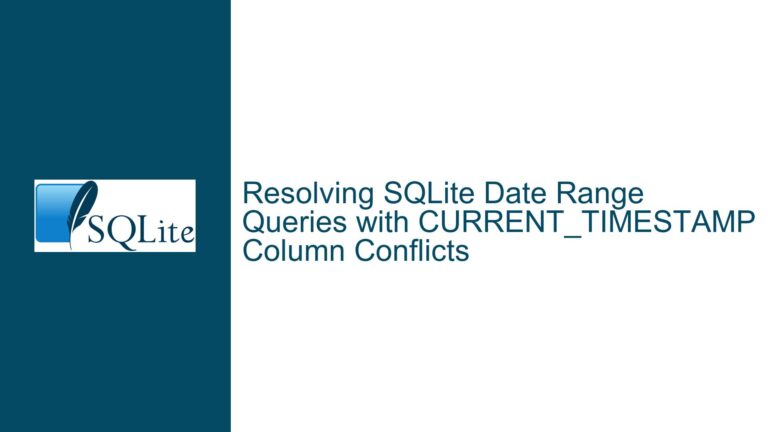Assertion Violation in sqlite3Select: Debugging and Resolving the Issue
Issue Overview: Assertion Failure in sqlite3Select Function
The core issue revolves around an assertion failure in the sqlite3Select function within SQLite. The assertion pExpr->iAgg==i fails, leading to an abrupt termination of the SQLite process with a core dump. This issue was identified using a grammar-based fuzzer named ATNwalk, which is designed to uncover edge cases and potential bugs in SQLite’s query processing logic. The specific query that triggers this assertion failure involves a complex UPDATE statement with nested subqueries, window functions, and a LEFT OUTER JOIN. The query attempts to update a table named dbstat while performing operations on aggregated data and window functions, which seems to confuse the SQLite query planner and execution engine.
The assertion failure occurs during the execution of the sqlite3Select function, which is responsible for processing SELECT statements and their derivatives. The function is a critical part of SQLite’s query execution engine, and the assertion pExpr->iAgg==i is intended to ensure that the aggregation context is correctly maintained throughout the query execution. When this assertion fails, it indicates a mismatch between the expected and actual aggregation state, which can lead to undefined behavior or crashes.
The query itself is highly complex, involving multiple layers of nested subqueries, window functions, and a LEFT OUTER JOIN. The use of VALUES clauses within the UPDATE statement further complicates the query, as does the use of the CURRENT_TIME keyword in the LIMIT clause. This complexity likely exposes a subtle bug in SQLite’s query planner or execution engine, particularly in how it handles aggregation and window functions in the context of an UPDATE statement.
Possible Causes: Aggregation Context Mismatch and Query Planner Limitations
The assertion failure in sqlite3Select suggests that there is a mismatch in the aggregation context during query execution. The assertion pExpr->iAgg==i is designed to ensure that the aggregation state is consistent throughout the query execution. When this assertion fails, it indicates that the aggregation state has become inconsistent, which can occur due to several reasons.
One possible cause is a bug in SQLite’s handling of window functions within an UPDATE statement. Window functions, such as cume_dist(), are designed to operate over a set of rows defined by a window frame. When used in conjunction with an UPDATE statement, the query planner must ensure that the window function is evaluated correctly within the context of the UPDATE operation. If the query planner fails to maintain the correct aggregation context, it can lead to the assertion failure observed in this case.
Another potential cause is the use of nested subqueries and VALUES clauses within the UPDATE statement. The query planner must correctly resolve the dependencies between the various subqueries and ensure that the aggregation state is maintained correctly across all levels of nesting. If the query planner fails to do so, it can lead to inconsistencies in the aggregation context, resulting in the assertion failure.
The use of the CURRENT_TIME keyword in the LIMIT clause may also contribute to the issue. The LIMIT clause is typically used to restrict the number of rows returned by a query, but in this case, it is being used in an unconventional manner. The query planner may not handle this usage correctly, leading to unexpected behavior and the assertion failure.
Finally, the issue may be related to the specific build configuration used in this case. The build includes several custom flags, such as -DSQLITE_DEBUG=1, -DSQLITE_ENABLE_UPDATE_DELETE_LIMIT=1, and -DSQLITE_ENABLE_RTREE=1, which may expose edge cases or bugs that are not present in the default build configuration. The use of AddressSanitizer (-fsanitize=address) may also contribute to the issue by detecting memory errors that would otherwise go unnoticed.
Troubleshooting Steps, Solutions & Fixes: Debugging and Resolving the Assertion Failure
To resolve the assertion failure in sqlite3Select, a systematic approach to debugging and fixing the issue is required. The following steps outline the process for identifying the root cause of the issue and implementing a fix.
Step 1: Reproduce the Issue in a Controlled Environment
The first step is to reproduce the issue in a controlled environment to ensure that the problem is consistently reproducible. This involves setting up a build environment with the same configuration as the one used in the original report. The build should include the custom flags and AddressSanitizer to ensure that the issue is not related to the specific build configuration.
Once the build environment is set up, the problematic query should be executed to confirm that the assertion failure occurs. This step is crucial for verifying that the issue is reproducible and for providing a baseline for further debugging.
Step 2: Analyze the Query Execution Plan
The next step is to analyze the query execution plan to understand how SQLite is processing the query. The EXPLAIN command can be used to generate a detailed execution plan for the query. The execution plan will provide insights into how SQLite is handling the various components of the query, including the nested subqueries, window functions, and LEFT OUTER JOIN.
The execution plan should be carefully examined to identify any potential issues or inefficiencies in the query processing. Particular attention should be paid to how SQLite is handling the aggregation context and window functions within the UPDATE statement. Any inconsistencies or unexpected behavior in the execution plan should be noted for further investigation.
Step 3: Debug the sqlite3Select Function
With the execution plan in hand, the next step is to debug the sqlite3Select function to identify the root cause of the assertion failure. This involves stepping through the function’s code using a debugger, such as gdb or lldb, to observe the state of the aggregation context at various points during query execution.
The debugger should be used to set breakpoints at key points in the sqlite3Select function, particularly around the assertion pExpr->iAgg==i. The state of the aggregation context should be examined at each breakpoint to identify any inconsistencies or mismatches that could lead to the assertion failure.
Step 4: Identify and Fix the Root Cause
Once the root cause of the assertion failure has been identified, the next step is to implement a fix. The fix may involve modifying the query planner to correctly handle the aggregation context in the presence of window functions and nested subqueries. Alternatively, the fix may involve modifying the sqlite3Select function to ensure that the aggregation state is correctly maintained throughout query execution.
The fix should be thoroughly tested to ensure that it resolves the assertion failure without introducing new issues. This involves running the problematic query and a suite of regression tests to verify that the fix works as expected.
Step 5: Validate the Fix and Submit a Patch
The final step is to validate the fix and submit a patch to the SQLite development team. The fix should be tested in a variety of environments to ensure that it is robust and does not introduce new issues. Once the fix has been validated, it should be submitted as a patch to the SQLite development team for review and inclusion in future releases.
In conclusion, the assertion failure in sqlite3Select is a complex issue that requires a systematic approach to debugging and fixing. By following the steps outlined above, the root cause of the issue can be identified and resolved, ensuring that SQLite continues to function correctly in the presence of complex queries involving window functions and nested subqueries.






